Key takeaways:
- Museums serve as vital connections, enhancing the understanding of classical literature through artifacts that reflect the cultural contexts of their time.
- Experiencing literature within museum exhibitions reveals the intricate ties between texts and their historical, philosophical, and personal backgrounds.
- Visits to museums inspire deeper engagement with literature, fostering creativity and encouraging dialogue about the evolving nature of storytelling.
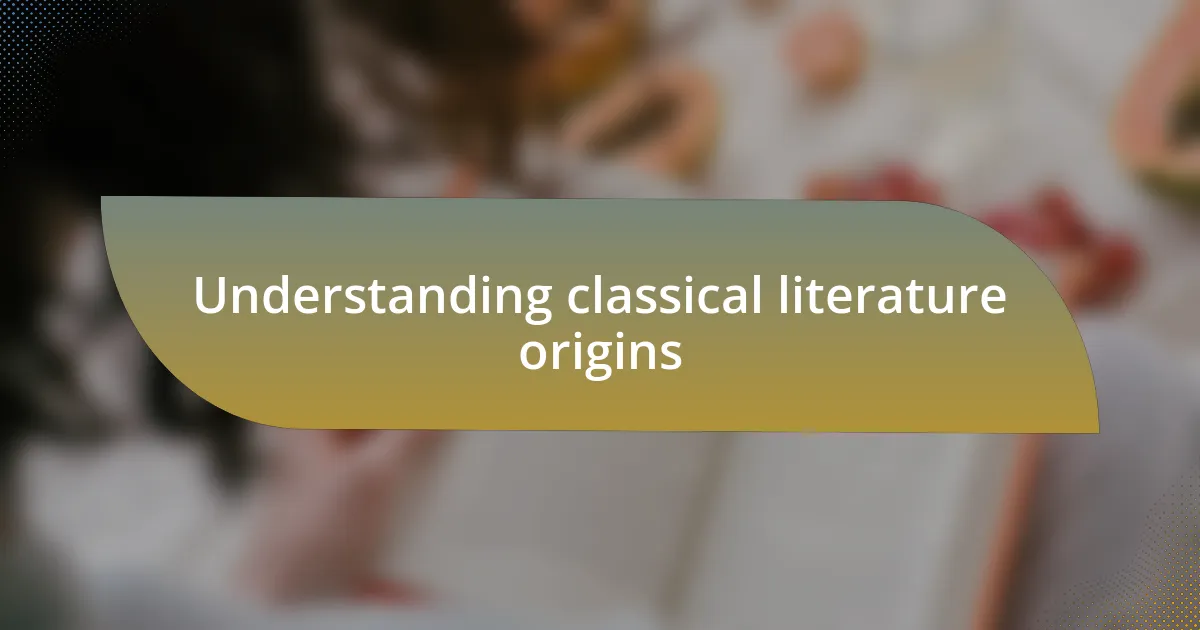
Understanding classical literature origins
Engaging with classical literature has always felt like peeling back layers of a rich, historical onion for me. Each visit to a museum seems to echo the voices of the past, drawn from ancient texts that shaped human thought. I often wonder, how many people have stood where I stand, absorbing the same stories and ideas that have transcended time?
Reflecting on my experiences amidst artifacts, I grapple with the powerful connections between these objects and the literature they inspired. For instance, discovering a fragment of a Greek vase depicting a scene from Homer’s “Iliad” stirred a profound appreciation within me. It made me realize that literature does not exist in a vacuum; it thrives within the cultural contexts that birthed it.
Sometimes, I catch myself asking, what if these ancient authors were able to see how their words would resonate through the ages? Their insights into humanity’s complexities continue to shape our collective understanding today. In visiting museums, I feel a sense of responsibility to honor their legacy by exploring the narratives they crafted and the values they challenged.
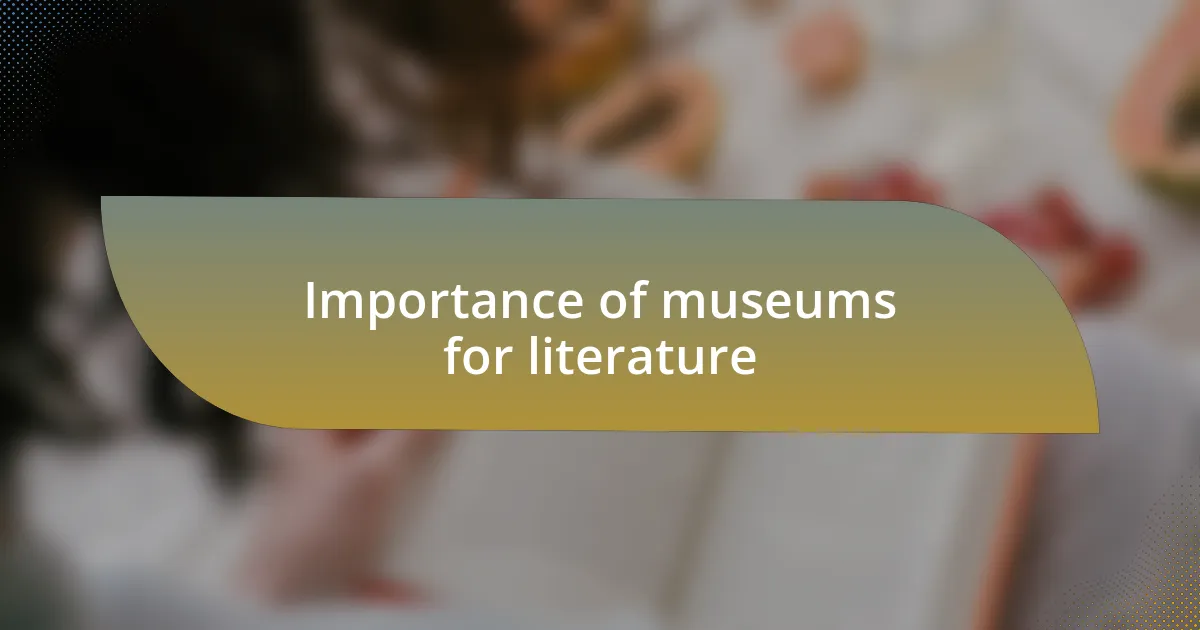
Importance of museums for literature
Museums serve as gateways to understanding the literary movements that influenced our favorite classical texts. I remember standing in front of the relics of the Renaissance, feeling a palpable energy in the air. It struck me then, how the art and innovations of that time set the stage for literary giants like Shakespeare and Cervantes. Isn’t it fascinating to think that these physical spaces can help us truly grasp the evolution of ideas?
When I encounter manuscripts in a museum, I often find myself reflecting on the painstaking efforts of authors who shaped literature as we know it. One visit, in particular, took me by surprise when I found an original copy of a 19th-century novel. The delicate pages felt like a bridge to another world, full of authorial intent and raw emotion. That moment reminded me that museums not only preserve history; they breathe life into the very words that have influenced generations.
Exploring the context of literature through museum exhibits deepens our understanding of its impact on societal values. As I wandered through displays linked to major literary movements, the conversations around themes of identity and morality became vivid. How could I not feel a sense of continuity connecting past authors to contemporary writers? These insights inspire me to engage with the texts more deeply and encourage others to appreciate the culture that nourished them.
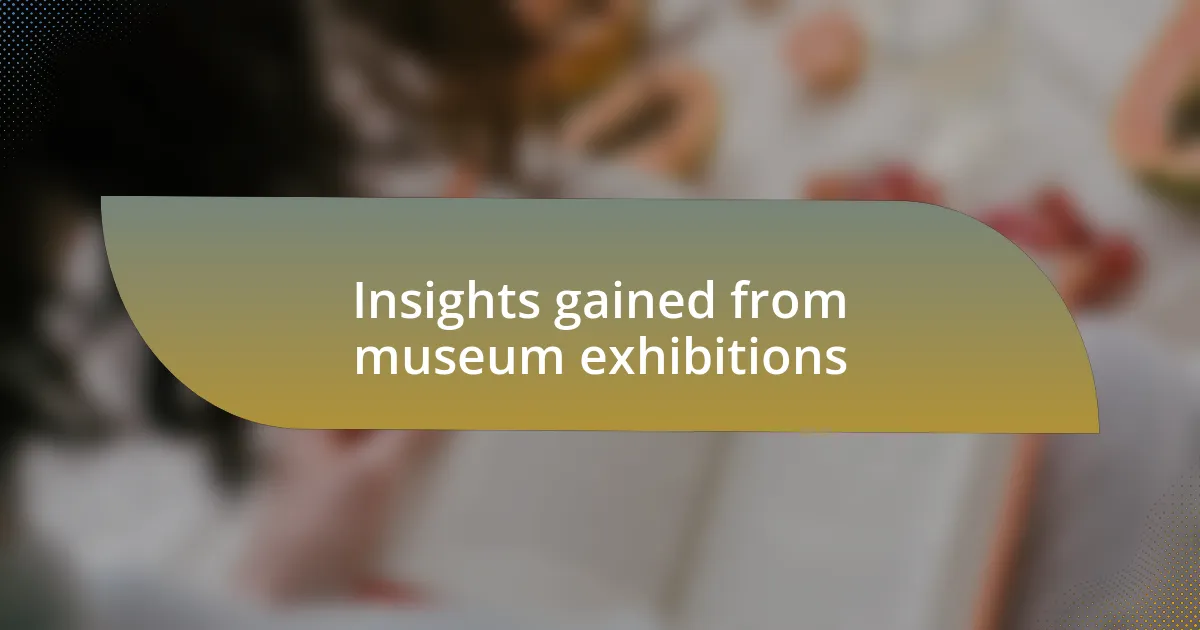
Insights gained from museum exhibitions
Museum exhibitions often reveal the intricate connections between literature and the broader cultural landscape. I fondly remember visiting an exhibit focused on the Age of Enlightenment. There, I discovered how philosophical ideas permeated literature, sparking the question: how does the thinking of an era shape its storytelling? This encounter made me appreciate not only the texts but also the intellectual currents that inspired their creation.
In another exhibition featuring artifacts from the Romantic period, I was struck by how deeply personal insights informed the writing of that time. One exhibit showcased letters exchanged between poets, revealing their vulnerabilities and inspirations. It made me realize that literature often stems from an artist’s intimate struggles. Does knowing the writer’s backstory enhance our reading experience? For me, it certainly does, allowing for a richer understanding of their work.
While wandering through a gallery dedicated to 20th-century literature, I encountered manuscripts that bore the authors’ own annotations and edits. I was moved by the tangible evidence of their creative process, and it prompted me to reflect on the idea that each piece of writing is a journey. As I examined those handwritten notes, a question lingered in my mind: how do revisions mirror personal growth? Witnessing their evolution gave me a newfound respect for the art of writing itself, inspiring me to embrace my own creative endeavors with authenticity and courage.

Key exhibits for classical literature
One of the most memorable exhibits I visited focused on ancient Greek literature, showcasing stone tablets with inscriptions of epic poems like the “Iliad” and the “Odyssey.” As I stood before these artifacts, I couldn’t help but feel a deep connection to the past. How did these stories transcend time? Observing the craftsmanship of the inscriptions, I realized that the essence of storytelling lies in its ability to resonate across generations, evoking emotions that remain relevant today.
In another exhibit dedicated to Roman literature, I encountered a collection of scrolls that included works by Cicero and Virgil. The tactile experience of reading these fragments was exhilarating. I found myself questioning how the formal structures of Latin influenced the poetic styles we see in contemporary works. This exploration made me appreciate the delicate balance between form and content—one that continues to shape literature as we know it.
Lastly, a particularly captivating exhibit highlighted the manuscripts of medieval writers, adorned with vibrant illustrations and marginalia. As I studied a page filled with notes from a scribe, I felt an overwhelming sense of respect for their painstaking efforts to preserve knowledge. It made me ponder: what drives individuals to document their thoughts for future generations? The passion evident in those manuscripts reminded me that literature is as much about emotion and dedication as it is about the text itself.
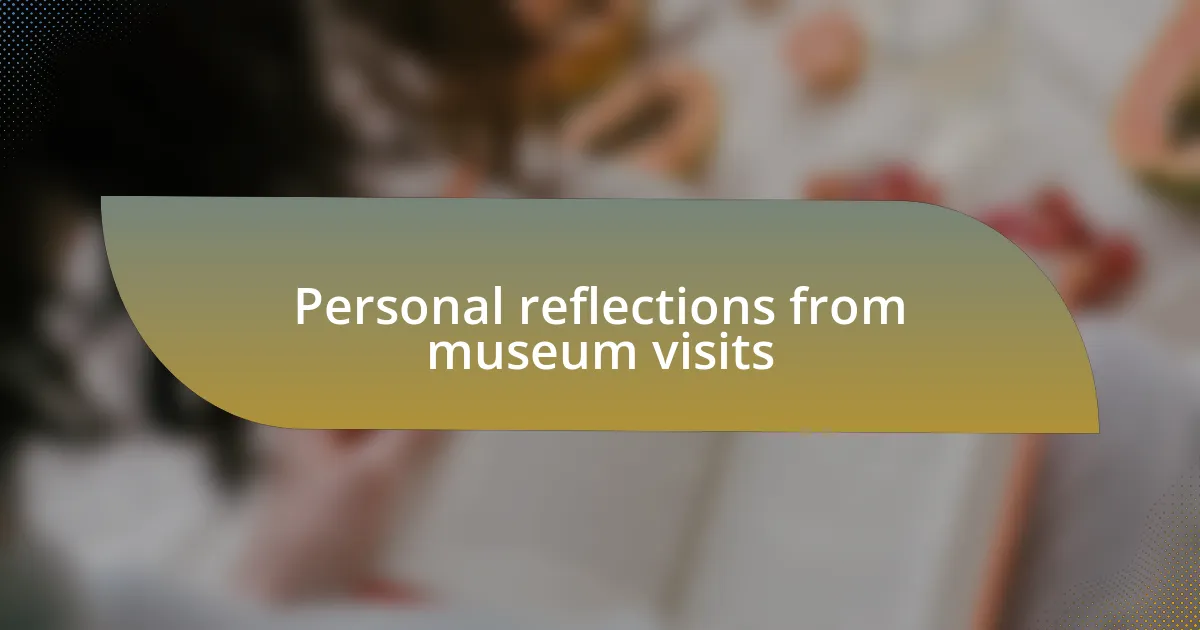
Personal reflections from museum visits
Walking through the museum halls, I remember the moment I stumbled upon an exhibit featuring artifacts from Shakespeare’s time. The atmosphere felt electric; I could almost hear the echoes of his words in the air. It made me reflect on how his characters and themes still ignite our imaginations today. What is it about his work that keeps pulling us back? It’s the universality of his insights into the human experience—love, betrayal, ambition—elements that resonate just as deeply now.
In another room, I encountered a stunningly preserved parchment containing excerpts from classic Roman tragedies. I found myself tracing the elegant script with my fingers, feeling an intense connection to the poet’s original thoughts. A wave of nostalgia washed over me, highlighting that literature isn’t just about the words waiting on the page but about the soul behind them. How often do we stop to consider the emotions embedded in the text? This experience illuminated for me the idea that literature is alive, with its roots stretching far into our collective psyche.
One visit involved examining contemporary interpretations of ancient texts through interactive displays. As I engaged with these installations, I felt a spark of inspiration. The fusion of old and new perspectives challenged me to consider how we continue to tell stories today. Do we honor our literary ancestors, or do we forge entirely new paths? This experience reminded me that our journey in literature is continual; we are all part of an evolving narrative that honors the past while daring to innovate for the future.
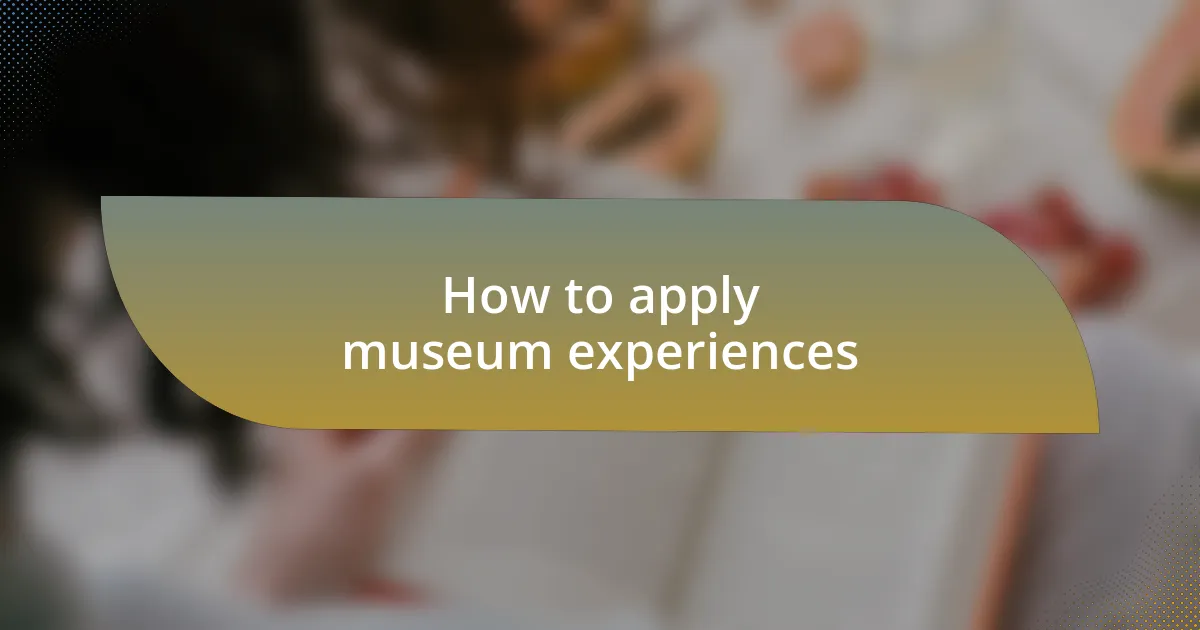
How to apply museum experiences
To apply the experiences gained from museum visits, I often think about how specific artifacts or displays can enhance my understanding of classical literature. For instance, while examining a relic connected to a favorite author, I felt as if I was invited into their world. It made me consider how their life experiences influenced their writing. Have you ever wondered how much the author’s environment shaped their narratives? Reflecting on this can deepen our appreciation of their work.
Museum visits can also inspire creative writing. When I witnessed a dramatic reconstruction of a scene from Greek tragedy, it sparked a story idea in my mind. The intensity of the actors and the atmosphere flooded me with inspiration. I realized that immersing myself in such experiences allows me to fuel my writing with authenticity and emotion. How often do we lose that spark in our daily routines? It’s essential to seek out these moments of connection and translate them into our own narratives.
Additionally, discussing museum experiences with fellow literature enthusiasts can lead to fascinating exchanges. I once shared my insights about a particular exhibit with a friend, and our conversation unveiled new interpretations of familiar texts. This dialogue encouraged us both to explore different angles and perspectives. Who knows what untapped ideas lie within our discussions? Engaging with others can illuminate aspects of literature that might otherwise remain hidden.